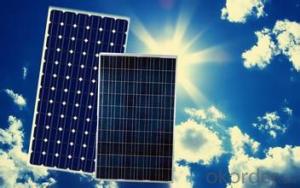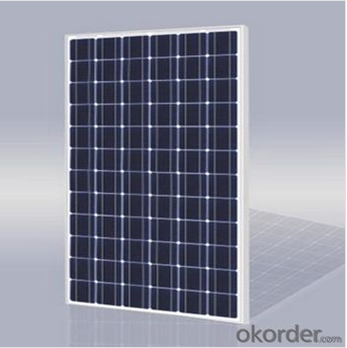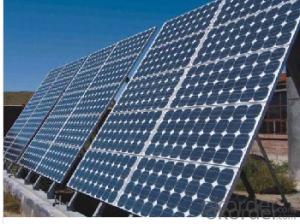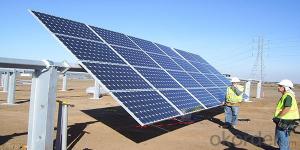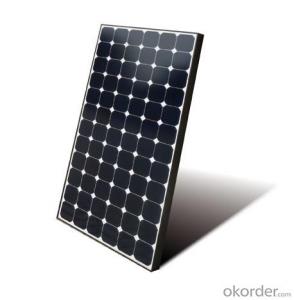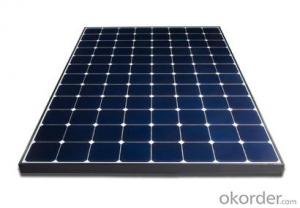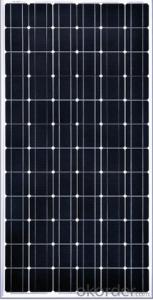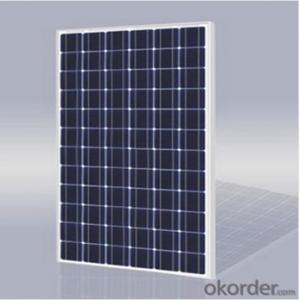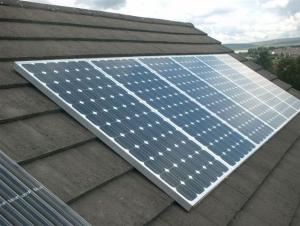Solar Panels Home Use - 65w CNBM Polycrystalline Silicon Panel
- Loading Port:
- China main port
- Payment Terms:
- TT OR LC
- Min Order Qty:
- 100 watt
- Supply Capability:
- 1000 watt/month
OKorder Service Pledge
OKorder Financial Service
You Might Also Like
Specification
65W CNBM Polycrystalline Silicon Panel for Home Using
Production description
Most solar modules are currently produced from crystalline silicon (c-Si) solar cells made of multicrystalline andmonocrystalline silicon. In 2013, crystalline silicon accounted for more than 90 percent of worldwide PV production, while the rest of the overall market is made up of thin-film technologies using cadmium telluride, CIGS and amorphous silicon[7]Emerging, third generation solar technologies use advanced thin-film cells. They produce a relatively high-efficiency conversion for the low cost compared to other solar technologies.

Feature
Optimized design for ease of soldering and lamination
Long-term stability,reliability and performance
Low breakage rate
Color uniformaity
Physical characteristic
1. Rigorous quality control meets the highest international standards.
2. High-transmissivity low-iron tempered glass, strong aluminium frame.
3. Using UV-resistant silicon.
4. IS09001/14001/CE/TUV/UL
- Q: Can solar panels power a whole house?
- Yes, solar panels can power a whole house depending on the size of the solar panel system, the energy requirements of the house, and the amount of sunlight available in the area. A properly sized solar panel system can generate enough electricity to meet the needs of a typical household, reducing or even eliminating the reliance on the traditional power grid.
- Q: Can solar panels be installed on historical or protected buildings?
- Yes, solar panels can be installed on historical or protected buildings. However, there are certain considerations and guidelines that need to be followed to ensure that the installation does not compromise the architectural integrity or cultural significance of the building. Special care is taken to design and install solar panels in a way that minimizes visual impact and preserves the historical value of the structure. Additionally, obtaining necessary permissions and approvals from relevant authorities is crucial before proceeding with the installation.
- Q: How can I start working as a solar panel installer/technician without years of education?
- The best suggestion I can give is to call solar installation companies in your area, and ask for their recommendation as to what to do. They may recommend a technical college with an appropriate program. With unemployment rising, new jobs in solar will likely be scarce for a while. You might also inquire at roofing companies. If you apply at a solar company, and can demonstrate that you already have roofing experience, that will be a plus.
- Q: Can solar panels be used in countries with limited sunlight?
- Yes, solar panels can still be used in countries with limited sunlight. While solar panels are most effective in regions with abundant sunlight, they can still generate electricity in areas with less sunlight. Even countries with limited sunlight exposure can benefit from solar energy by utilizing advanced solar technologies and optimizing panel placement to maximize energy production. Additionally, solar panels can still generate electricity on cloudy or overcast days, although at a reduced efficiency compared to sunny days.
- Q: I found portable solar panels used for boats etc. and was wondering how I could effectly use them for my home instead. If you have used them in the past, please tell how they worked (good or bad).
- portable panels are too small to be much use for a modern household. A panel appx 20 inches square might supply a laptop computer... but it won't keep your refrigerator running.
- Q: Can solar panels be installed on outdoor event venues?
- Yes, solar panels can be installed on outdoor event venues. Solar panels are versatile and can be mounted on various surfaces, including rooftops, canopies, and even the ground. Installing solar panels on event venues can help generate clean and renewable energy, reducing reliance on traditional power sources and minimizing carbon emissions. Additionally, solar panels can provide shade and protect attendees from the sun, creating a more comfortable environment during outdoor events.
- Q: Is it possible for the everyday person to increase the efficiency of solar panels that they own? If so, how is it done?
- If you have a way to keep silicon panels cool, that really helps. On a hot summer day, our array was down 20% in production. I sprayed a hose to wash the panels, and for a few minutes, the power spiked to 20% ABOVE normal. The usual thing to do is mount the panels exposed to the wind if you can, or at least 8 off the roof otherwise. A few lucky souls with access to free stream water on their property have been known to use water cooling under their panels.
- Q: hey, i am wanting to help our earth a little bit, and I was wondering how to do a solar panel connection for powering my home.... i just want to reduce my energy bill a little bit, Would these solar panels work?and how would i connect them?
- I okorder
- Q: How much per sq inch do they cost? Will i have to worry about them blowing off during hurricane season? If the sun isnt out for a week will my power go out? Will I have to check them every week and check which ones arent working and replace them? Is there anyway for them to be damaged by acid rain or any type of erosion like hail? When do I have to replace them? How do I dispose of old ones (like recycling)? What is smarter and more economical having few big panels or many small ones? I know I have alot of questions but I want a good detailed answer.
- The cost of solar is measured in dollars per watt. That means the cost of a cell that can make one watt continuously in full sunlight. A friend of mine is starting a new job to set up a new solar cell factory and he said the present cost is $3 per watt, but that they expect to get that down to $ per watt in a few years. They can be damaged by weather, just like any regular roof. My insurance agent asked if I had solar panels, so it is a factor in insurance cost. I never heard of recycling or disposing of old panels, maybe because they are so new and last so long that not many are ready to be disposed of yet.
- Q: i trying to make a solar panel. right now i dont have money to go and buy a copper sheet. so can i make it out of aluminum foil. if there is a way please tell me how. and what do i use for wires. i making this to charge batteries.
- No but look in youtube for other ways of charging batteries . There is allot of neat ideas like building a small wind generator from scrap parts such as old speaker magnets copper wire out of transformers things that most people toss in the junk .
Send your message to us
Solar Panels Home Use - 65w CNBM Polycrystalline Silicon Panel
- Loading Port:
- China main port
- Payment Terms:
- TT OR LC
- Min Order Qty:
- 100 watt
- Supply Capability:
- 1000 watt/month
OKorder Service Pledge
OKorder Financial Service
Similar products
Hot products
Hot Searches
Related keywords
